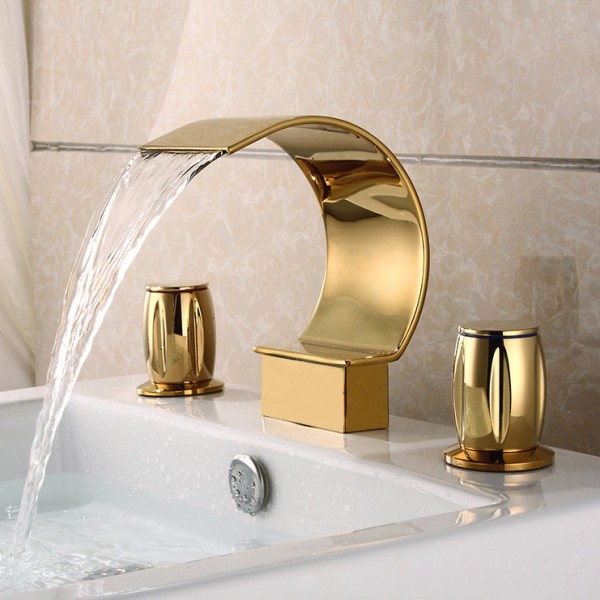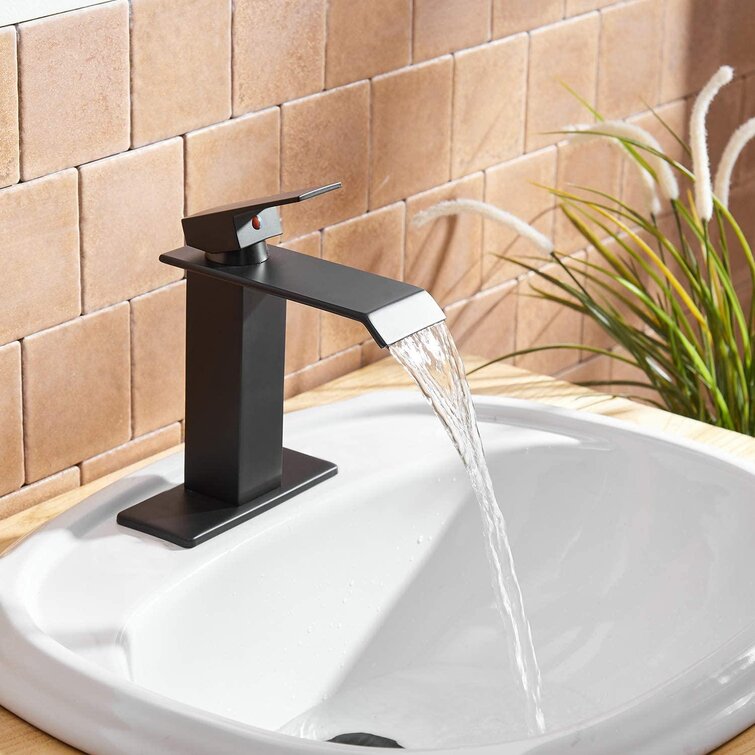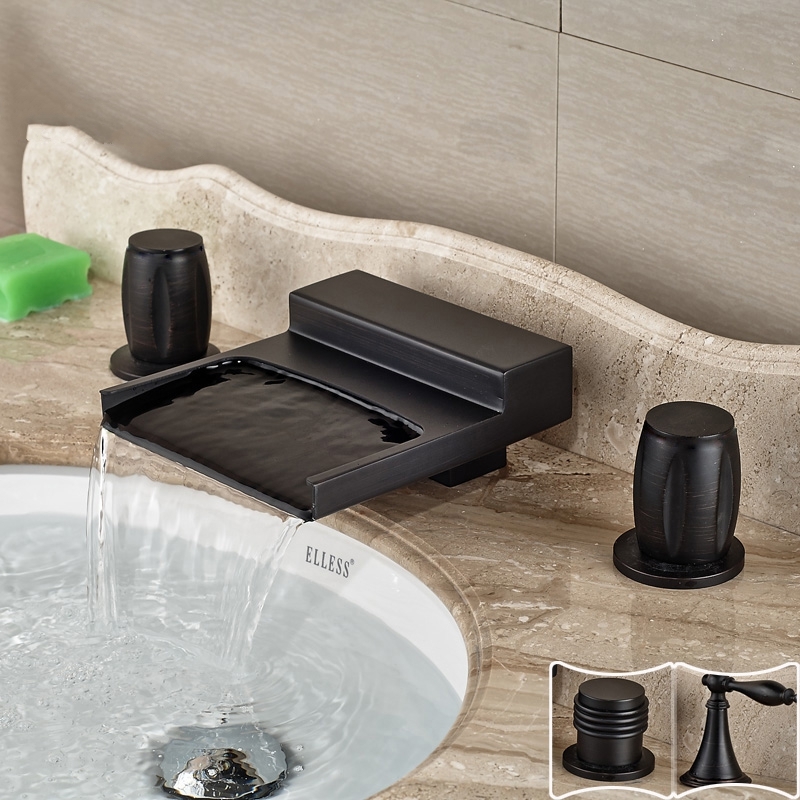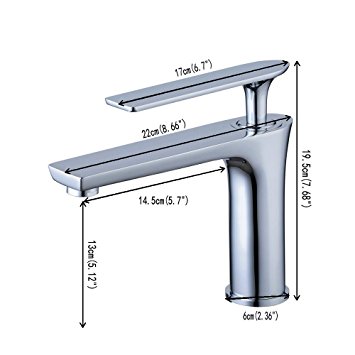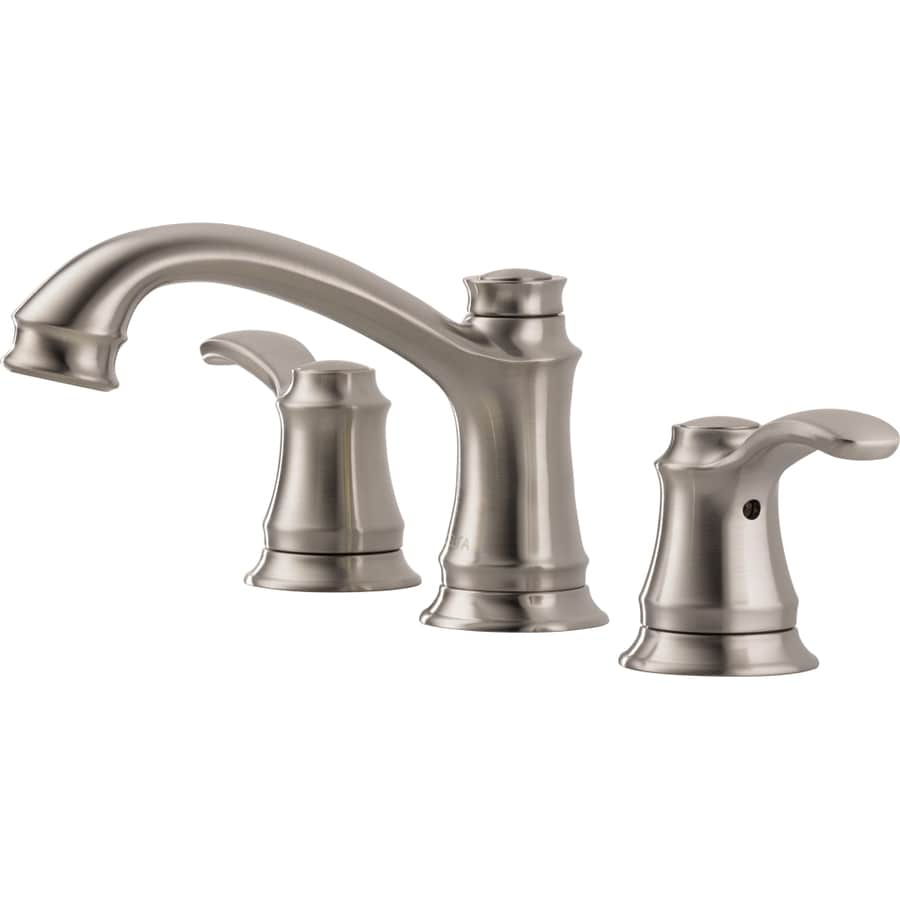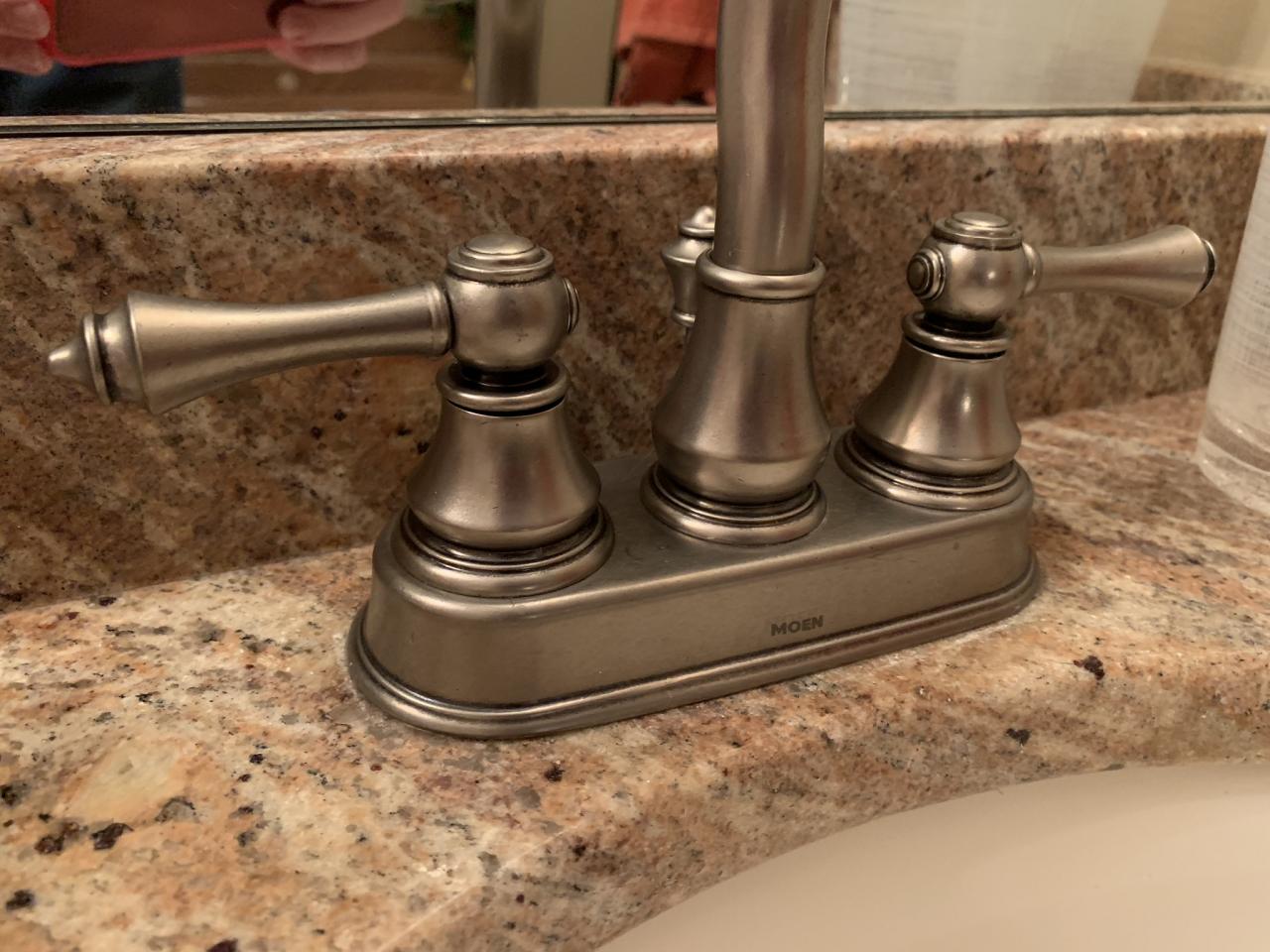Introduction to Modern Waterfall Bathroom Faucets
What is a Waterfall Faucet?
Modern waterfall bathroom faucets are innovative fixtures designed to mimic the flow of water in nature. These faucets allow water to cascade down in a flat, even stream, resembling a waterfall. This unique design provides a serene and elegant aesthetic, transforming an ordinary bathroom into a spa-like retreat. Waterfall faucets are available in a variety of styles and finishes, making them a versatile choice for contemporary bathrooms.
The Evolution of Faucet Design
Waterfall faucets represent a significant evolution in faucet design. Traditional faucets often focus solely on functionality, with little regard for visual appeal. In contrast, waterfall faucets combine form and function, offering both practicality and aesthetic beauty. The concept of a waterfall faucet aligns with modern design principles, which emphasize sleek lines, minimalism, and a connection to nature. As a result, these faucets have become increasingly popular in recent years.
Features of Modern Waterfall Faucets
Modern waterfall faucets are characterized by several key features. They typically have a wide spout that allows water to flow smoothly and evenly. The flow of water is often more gentle than traditional faucets, creating a soothing effect. Many waterfall faucets are designed with eco-friendly features, such as water-saving aerators. Additionally, they are available in a range of styles, from wall-mounted to vessel sink faucets, providing options for different bathroom layouts.
Versatility and Compatibility
One of the appealing aspects of waterfall faucets is their versatility. They can be integrated into various bathroom designs, from ultra-modern to transitional styles. Waterfall faucets are compatible with a range of sink types, including vessel, undermount, and drop-in sinks. This adaptability makes them a practical choice for homeowners looking to update their bathroom fixtures. Furthermore, they come in numerous finishes, such as chrome, brushed nickel, and oil-rubbed bronze, allowing for customization.
The Luxurious Experience
Installing a waterfall faucet can elevate the overall bathroom experience. The gentle flow of water creates a relaxing ambiance, akin to the tranquility found in nature. This luxurious experience can make everyday tasks, such as washing hands or brushing teeth, more enjoyable. For those seeking to create a spa-like environment at home, a waterfall faucet is an ideal addition. It not only enhances the visual appeal of the bathroom but also contributes to a sense of well-being.
Investing in Quality
When choosing a waterfall faucet, it’s important to invest in quality. High-quality faucets are made from durable materials that resist corrosion and wear. They also feature precise engineering to ensure a smooth and consistent flow of water. Investing in a reputable brand can provide peace of mind, knowing that the faucet will perform reliably for years to come. By selecting a well-made waterfall faucet, homeowners can enjoy the perfect blend of beauty and functionality.

Benefits of Installing a Waterfall Faucet
Aesthetic Appeal
One of the primary benefits of installing a waterfall faucet is its aesthetic appeal. The elegant and modern design of these faucets can instantly upgrade the look of any bathroom. The smooth, cascading flow of water is visually pleasing and can serve as a focal point in the bathroom. Waterfall faucets are available in various styles and finishes, allowing homeowners to choose a design that complements their bathroom decor and personal taste.
Enhanced User Experience
Waterfall faucets provide an enhanced user experience compared to traditional faucets. The gentle flow of water is not only soothing but also practical for everyday use. Washing hands, face, or even filling a glass with water becomes a more enjoyable task. The wide spout design ensures that water flows smoothly and evenly, reducing splashing and making it easier to use the sink. This improved functionality makes waterfall faucets a desirable choice for modern bathrooms.
Eco-Friendly Features
Many modern waterfall faucets are designed with eco-friendly features that help conserve water. These faucets often include aerators, which mix air with water to maintain pressure while reducing water usage. This not only helps save on water bills but also contributes to environmental conservation. By choosing a waterfall faucet with water-saving technology, homeowners can enjoy a luxurious bathroom fixture while being mindful of their ecological footprint.
Increased Home Value
Upgrading to a waterfall faucet can potentially increase the value of a home. Bathrooms are one of the key areas that prospective buyers focus on, and modern, stylish fixtures can make a significant impression. A well-designed bathroom with high-quality features, such as a waterfall faucet, can enhance the overall appeal of a home. This investment can pay off by making the home more attractive to potential buyers and possibly leading to a higher selling price.
Easy Maintenance
Waterfall faucets are generally easy to maintain, especially those made from high-quality materials. The design typically has fewer crevices and joints where dirt and grime can accumulate, making them easier to clean. Regular wiping with a soft cloth can keep the faucet looking shiny and new. Additionally, many waterfall faucets have finishes that resist tarnishing and corrosion, ensuring they maintain their appearance over time. This ease of maintenance adds to the overall convenience of having a waterfall faucet in the bathroom.
Versatility in Design
Another benefit of waterfall faucets is their versatility in design. They can be paired with a variety of sink types and bathroom styles, from modern to rustic. Whether you have a vessel sink, undermount sink, or drop-in sink, there’s a waterfall faucet that will fit perfectly. This adaptability allows homeowners to personalize their bathroom according to their preferences. The wide range of available finishes also means that the faucet can match or complement other bathroom fixtures and accessories.
Design and Style Considerations
Contemporary Aesthetics
Modern waterfall faucets are known for their sleek and contemporary aesthetics. When choosing a waterfall faucet, consider the overall style of your bathroom. If your bathroom has a minimalist design, opt for a faucet with clean lines and a simple silhouette. For a more luxurious look, choose a waterfall faucet with a bold, sculptural design. The key is to select a faucet that enhances the existing decor and creates a cohesive look.
Finish Options
The finish of a waterfall faucet can significantly impact its appearance and how well it blends with other bathroom fixtures. Common finishes include chrome, brushed nickel, oil-rubbed bronze, and matte black. Chrome and brushed nickel finishes are versatile and can complement a wide range of styles, from modern to traditional. Oil-rubbed bronze adds a rustic, vintage touch, while matte black offers a contemporary, edgy look. Consider the finishes of other fixtures in your bathroom when selecting your waterfall faucet to ensure a harmonious design.
Spout Design
The design of the spout is a crucial consideration for waterfall faucets. The spout should be wide enough to allow for a smooth, even flow of water. Some spouts have a flat, open design, while others feature a more enclosed, channel-like structure. The open spout design provides a more dramatic waterfall effect, while the enclosed design can offer a more controlled flow. Consider the level of water flow and splash you prefer when choosing the spout design.
Mounting Options
Waterfall faucets come in various mounting options, including wall-mounted, deck-mounted, and vessel-mounted. Wall-mounted faucets are installed directly into the wall, providing a clean and uncluttered look. Deck-mounted faucets are installed on the countertop or sink, making them a versatile option for different sink types. Vessel-mounted faucets are specifically designed for vessel sinks, with a taller spout to accommodate the height of the sink. Choose the mounting option that best suits your bathroom layout and sink type.
Handle Styles
The style and placement of the handle are important design considerations. Some waterfall faucets feature a single lever handle, which allows for easy temperature and flow control. Others have two handles, providing a more traditional look and precise control over hot and cold water. The handle can be integrated into the spout or mounted separately, depending on the design. Consider the ease of use and overall aesthetics when choosing the handle style for your waterfall faucet.
Coordinating with Bathroom Decor
To create a cohesive look, coordinate your waterfall faucet with other elements in your bathroom. This includes the sink, countertop, cabinetry, and other fixtures such as towel bars and showerheads. For a unified design, choose a faucet finish that matches or complements these elements. Additionally, consider the overall color scheme and style of your bathroom. A waterfall faucet should enhance the decor and contribute to a harmonious and stylish space.
Material Options for Waterfall Faucets
Brass
Brass is a popular material for waterfall faucets due to its durability and resistance to corrosion. It has a classic, timeless appeal and can be finished in various ways, including polished, brushed, or antiqued. Brass faucets are known for their sturdiness and ability to withstand frequent use. They are also resistant to rust, making them ideal for bathroom environments. When choosing a brass waterfall faucet, ensure it has a high-quality finish to prevent tarnishing over time.
Stainless Steel
Stainless steel is another durable and corrosion-resistant material commonly used for waterfall faucets. It has a sleek, modern appearance and is easy to maintain. Stainless steel faucets are resistant to staining and scratching, making them a practical choice for busy bathrooms. They are also hypoallergenic, which is beneficial for households with sensitive skin. The neutral, versatile look of stainless steel complements a wide range of bathroom styles.
Zinc Alloy
Zinc alloy is a cost-effective material often used for budget-friendly waterfall faucets. While it may not be as durable as brass or stainless steel, zinc alloy faucets can still provide good performance and aesthetic appeal. They are typically finished with a chrome or brushed nickel coating to enhance their appearance and resistance to corrosion. Zinc alloy faucets are lightweight and easy to install, making them a convenient option for DIY projects.
Ceramic
Ceramic materials are commonly used for the internal components of waterfall faucets, such as the cartridge. Ceramic cartridges are highly durable and resistant to wear, providing smooth and reliable operation. Some waterfall faucets also feature ceramic handles or accents, adding a decorative touch. While ceramic components enhance the longevity and functionality of the faucet, they are typically combined with other materials, such as brass or stainless steel, for the main structure.
Glass
Glass waterfall faucets offer a unique and striking design. The spout is often made of tempered glass, allowing the water to cascade beautifully. Glass faucets can create a dramatic focal point in the bathroom, adding a touch of elegance and modernity. However, they require careful handling and regular cleaning to maintain their appearance. Ensure that the glass used is tempered for safety and durability.
Composite Materials
Composite materials, such as plastic or resin, are sometimes used for affordable waterfall faucets. While they may not offer the same level of durability as metal faucets, they can still provide an attractive and functional option. Composite faucets are lightweight and easy to install, making them suitable for DIY projects. They are also available in various finishes and colors, allowing for customization. When choosing a composite faucet, look for high-quality materials to ensure longevity and performance.
Installation Guide: How to Set Up Your Waterfall Faucet
Preparing for Installation
Before installing your waterfall faucet, gather all necessary tools and materials. This typically includes a wrench, plumber’s tape, silicone sealant, and a basin wrench. Ensure that you have the faucet components and any included instructions. Turn off the water supply to the sink and open the faucet to release any remaining water. If replacing an existing faucet, remove it carefully and clean the area around the sink or countertop.
Assembling the Faucet
Start by assembling the waterfall faucet according to the manufacturer’s instructions. This may involve attaching the spout, handles, and any other components. Use plumber’s tape on threaded connections to ensure a watertight seal. If your faucet has a deck plate, install it on the sink or countertop, securing it with the provided screws or bolts. Place the faucet body on the deck plate and tighten it securely.
Connecting the Water Supply Lines
Next, connect the water supply lines to the faucet. Attach the hot and cold water lines to the corresponding inlets on the faucet. Use a wrench to tighten the connections, ensuring they are secure but not overly tight. Apply plumber’s tape to the threads if needed to prevent leaks. Once the supply lines are connected, attach the other end to the shut-off valves under the sink.
Installing the Drain Assembly
If your waterfall faucet comes with a drain assembly, install it according to the instructions. This typically involves placing the drain flange in the sink’s drain hole and securing it with a gasket and nut underneath. Attach the drain pipe to the flange and connect it to the P-trap. Apply silicone sealant around the drain flange to prevent leaks. Ensure all connections are tight and secure.
Testing for Leaks
Turn on the water supply and check for leaks. Open the faucet and allow water to flow through both the hot and cold lines. Inspect all connections, including the supply lines and drain assembly, for any signs of water leakage. If you notice any leaks, tighten the connections as needed or apply additional plumber’s tape. Once you are confident that there are no leaks, wipe down the faucet and surrounding area.
Final Adjustments
Make any final adjustments to ensure the faucet is functioning correctly. Check that the handles operate smoothly and that the water flows evenly from the spout. Adjust the water flow and temperature settings as needed. If your faucet includes a pop-up drain, ensure it opens and closes properly. Finally, clean the faucet and sink area, removing any debris or excess sealant. Your waterfall faucet is now ready for use.
Maintenance Tips for Longevity
Regular Cleaning
To keep your waterfall faucet looking its best, regular cleaning is essential. Wipe down the faucet daily with a soft, damp cloth to remove water spots and prevent mineral buildup. For deeper cleaning, use a mild soap and water solution or a non-abrasive cleaner. Avoid using harsh chemicals or abrasive pads that can scratch the finish. Regular cleaning not only maintains the faucet’s appearance but also prevents potential damage over time.
Preventing Mineral Buildup
Mineral buildup from hard water can affect the performance and appearance of your waterfall faucet. To prevent this, regularly clean the aerator and spout. Soak the aerator in a vinegar solution to dissolve mineral deposits, then rinse thoroughly. For the spout, use a soft brush or cloth to remove any buildup. If you live in an area with hard water, consider installing a water softener to reduce mineral deposits and prolong the life of your faucet.
Checking for Leaks
Periodically check your waterfall faucet for leaks to ensure it remains in good working condition. Inspect the connections under the sink, the handles, and the spout for any signs of water leakage. Tighten any loose connections and replace worn-out washers or seals as needed. Addressing leaks promptly can prevent water damage and prolong the lifespan of your faucet. Regular maintenance checks can also help identify and fix potential issues before they become major problems.
Protecting the Finish
Protecting the finish of your waterfall faucet is crucial for maintaining its appearance. Avoid using abrasive cleaners or scrubbers that can scratch the surface. Instead, use a soft cloth and a gentle cleaning solution. For faucets with a polished or brushed finish, consider using a polish designed for that specific material to keep it looking shiny and new. If your faucet has a matte or textured finish, follow the manufacturer’s cleaning recommendations to avoid damage.
Handling Repairs
If your waterfall faucet requires repairs, follow the manufacturer’s guidelines or consult a professional plumber. Common issues, such as a dripping faucet or a loose handle, can often be fixed with simple repairs. For example, replacing a worn-out washer or tightening a loose connection can resolve many problems. However, for more complex issues, such as a malfunctioning cartridge, it’s best to seek professional assistance. Properly handling repairs ensures the longevity and reliability of your faucet.
Seasonal Maintenance
Performing seasonal maintenance can help keep your waterfall faucet in optimal condition. In colder months, prevent freezing by insulating the pipes and maintaining a consistent indoor temperature. In warmer months, check for any signs of wear or damage caused by increased humidity. Regularly inspect the faucet and its components, such as the aerator and handles, for any signs of corrosion or wear. Seasonal maintenance helps prevent issues and keeps your faucet functioning smoothly throughout the year.
Enhancing Your Bathroom with Complementary Accessories
Coordinating Hardware
Enhancing your bathroom with complementary accessories can create a cohesive and stylish look. Start by coordinating the hardware, such as towel bars, robe hooks, and drawer pulls, with your waterfall faucet. Choose finishes and styles that match or complement the faucet to create a unified design. For example, if your faucet has a brushed nickel finish, opt for brushed nickel hardware. This coordination adds a polished and sophisticated touch to your bathroom.
Stylish Mirrors
A stylish mirror can significantly enhance the overall look of your bathroom. Consider a mirror with a frame that complements your waterfall faucet. For a modern bathroom, choose a mirror with a sleek, minimalist frame. For a more rustic look, opt for a wooden frame that adds warmth and texture. Additionally, consider the size and shape of the mirror to ensure it fits well with the faucet and sink area. A well-chosen mirror can serve as a focal point and enhance the visual appeal of your bathroom.
Lighting Solutions
Proper lighting is essential for both functionality and aesthetics in the bathroom. Choose lighting fixtures that complement your waterfall faucet and overall bathroom design. Wall sconces on either side of the mirror provide balanced and flattering light. Pendant lights or a statement chandelier can add a touch of elegance and style. Ensure the lighting is bright enough for daily tasks, such as shaving or applying makeup, but also consider dimmable options for creating a relaxing ambiance.
Decorative Storage
Adding decorative storage solutions can enhance the functionality and style of your bathroom. Consider using baskets, trays, or shelves that complement the finish and design of your waterfall faucet. These storage solutions can help keep your bathroom organized while adding a decorative element. For example, woven baskets can add a natural, rustic touch, while glass or metal trays can provide a sleek, modern look. Use these storage options to keep toiletries, towels, and other essentials neatly arranged.
Textiles and Linens
Textiles and linens play a significant role in the overall look and feel of your bathroom. Choose towels, bath mats, and shower curtains that coordinate with your waterfall faucet and bathroom decor. Consider using complementary colors and patterns to create a cohesive design. High-quality, plush towels and mats can add a touch of luxury and comfort. Additionally, consider incorporating natural materials, such as cotton or linen, to enhance the spa-like ambiance.
Personal Touches
Adding personal touches to your bathroom can make it feel more inviting and uniquely yours. Consider incorporating artwork, such as framed prints or photographs, that reflect your style and personality. Display decorative items, such as candles, vases, or plants, that complement the overall design. Personal touches can make your bathroom feel more comfortable and enjoyable. Remember to choose items that enhance the decor without cluttering the space.
Related Posts:
- Bathroom Faucet Drain Stopper
- Bathroom Faucet Shut Off Valve
- How To Repair A Moen Bathroom Faucet
- Delta Vessona Bathroom Faucet
- Bathroom Faucet Outlet
- Brushed Stainless Steel Bathroom Faucet
- How To Fix A Leaky Moen Single Handle Bathroom Faucet
- Bathroom Faucets El Paso Tx
- Hansgrohe Single Handle Bathroom Faucet
- Bathroom Faucets Gold Tone
/mall/2021/04/06/fe40fb6124ed4156ad1d09507df85b51.jpg)




/mall/file/2021/06/15/3564780c0f5c4b8297699017be9b92d8.jpg)
